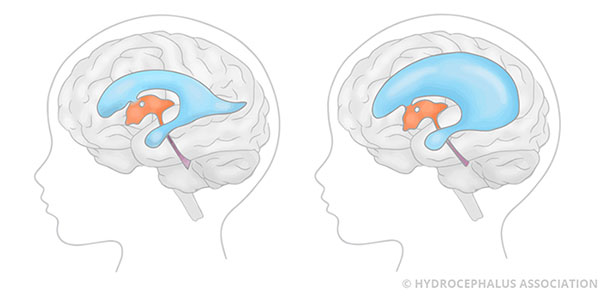Neurosurgery, Brain & Spine
Hydrocephalus
Understanding Normal Pressure Hydrocephalus

Normal pressure hydrocephalus (NPH) is an increase in the volume of cerebrospinal fluid (CSF) that normally fills the ventricles of the brain and surrounds the brain and spinal cord.
As a normal part of the aging process, the ventricles often appear enlarged on brain imaging, but the enlarged ventricles may also be the result of obstruction termed NPH. The latter condition originated from Dr. Salomon Hakim’s 1964 paper in which he describes cases of hydrocephalus with normal CSF pressure that presented with a triad (group of 3) symptoms.
-
The symptoms are insidious and progressive:
- Gait disturbance and/or impaired balance or falls—the gait often described as shuffling with short steps.
- Cognitive decline or mild dementia.
- Bladder urgency that may progress to loss of bladder control.
-
NPH may be caused by prior injury to the brain, bleeding, infection, tumor, or prior surgery termed secondary NPH. However, the cause is often unknown and termed primary or idiopathic NPH.CSF cushions the brain and brings nutrients to and waste away from the brain. In NPH, the CSF accumulates. To accommodate the increase in CSF volume, the ventricles expand, which compresses the surrounding brain and results in the triad of symptoms.
-
The Hydrocephalus Association estimates that more than 800,000 Americans have NPH but fewer than 20% receive the diagnosis, as it often goes unrecognized. 1% to 5% of patients with dementia are estimated to have NPH. NPH is one of the few causes of dementia that can be treated.
-
The diagnosis of NPH may be challenging because the triad of symptoms are common, and each may have multiple causes. In addition, the symptoms may overlap with other common conditions such as Parkinsonism and Alzheimer’s disease. The evaluation by a multidisciplinary team includes:
- Discussion of patient symptoms and physical examination including evaluation of gait.
- Brain imaging (CT or MRI) and laboratories.
- Lumbar puncture to simulate treatment for NPH and determine shunt responsiveness.

Treatment and What to Expect
Treatment is a flexible tube (shunt) surgically placed into the ventricles of the brain that slowly drains CSF from the ventricles into the abdomen where it is usually absorbed. Programmable valves permit for fine-tuning the rate of CSF drainage. These adjustments are made noninvasively in the office using a magnet.
Outcomes After Shunt Surgery
Symptom improvement following shunt surgery is determined by the criteria used to evaluate patients as candidates. These criteria are primarily based on the evaluation of gait and balance before and after lumbar puncture. While the shunt is not a cure, it often improves the symptoms of NPH. According to the Hydrocephalus Association, 80% of patients who are accurately diagnosed with NPH and evaluated for shunt responsiveness will demonstrate improvement, but it may take weeks or months to appreciate the full benefit.
Who Should Be Evaluated
Idiopathic NPH usually occurs in patients 60 years old and older, but secondary NPH may occur at any age. Patients with gait and cognitive impairment and/or bladder disturbance may warrant brain imaging followed by a referral for assessment for NPH.

Resources
To learn more about NPH and to find support, please visit the Hydrocephalus Association.
Meet Our Expert
Location

USF Health South Tampa Center for Advanced Healthcare
2 Tampa General Circle
Tampa, FL 33606
Appointments: (813) 821-8034

